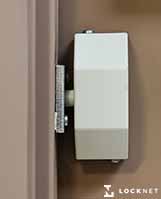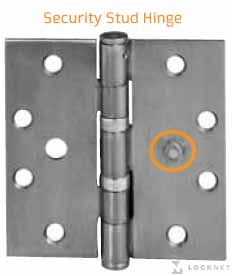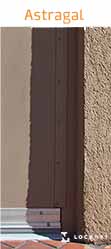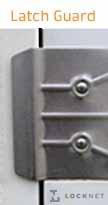Panic bars are a hot topic in the loss prevention and facilities management world. At a recent trade show, an attendee asked about the options available for rear door security. As a large national chain, his organization had fallen victim to some creative criminals. By prying out the bottom of the door, robbers were able to crawl in and raid their stores after hours. This isn’t the first time the issue had been a trade show topic of conversation– believe it or not, it’s a common problem.
There are a lot of “solutions” out there, but only a handful of them are code compliant. Some industry professionals will recommend using police bars which do, in fact, solve the immediate issue of robbery and theft; but unless these are removed during hours of operation, you will incur a hefty fine for installing these.
Others will suggest extra slide bolts and/or deadbolts. Again-unless they are always unlocked when you are open for business – it’s a serious life safety concern and code violation. The most important thing to keep in mind when it comes to exit doors is that you must be able to get out with one action.
So, what’s the code compliant solution? There are four main security features; installing any combination of these will greatly increase the security of your back doors.
 Hinge Side Deadbolt
Hinge Side Deadbolt
A hinge side deadbolt is an additional piece of hardware that is installed on the door and secures into a hole cut into the frame. You can install as many of these as you like – go crazy! Anywhere from one to three should suffice, but if you want to attain Fort Knox level security, knock yourself out. In the picture to the right, we have just one installed on our exit door. (As an added level of security we also have the Sur-Lock exit device installed-talk about sturdy!)
Panic Bars – Multi-Point Locking Systems
Essentially, any device (or combination of devices) that secures the door into the opening in multiple places is considered a multi-point locking system. There are two main panic bars available that allow for code compliance on exit doors; the Securitech Trident and the Detex ECL-230X-TBD. While these panic bars are undoubtedly secure,  if these products don’t fit your budget, adding hinge side deadbolts to any door with an existing panic bar will convert your current device into a multi-point locking system.
if these products don’t fit your budget, adding hinge side deadbolts to any door with an existing panic bar will convert your current device into a multi-point locking system.
Securitech Trident
The Securitech Trident exit device is a four-point locking system. It is a three point panic bar with the addition of a hinge side deadbolt. The device engages onto the latch side of the frame in three places, and engages into the hinge side of the frame in one. Trust me when I say that this device provides a very high level of security. If (and that’s a big if) robbers were able to pry the door open, it would take them a VERY long time – the cops would be there well before they were able to enter your location. Check out this video of a staged break-in to see just what I’m talking about.
Detex ECL-230X-TBD
The Detex EXL-230X-TBD exit device is a three point locking system panic bar that engages into the strike jamb, header, and footer of the opening. You can add a hinge side deadbolt to make it a four-point locking system just as Securitech has done. Much like the Trident, this device is quite tenacious while providing an extremely high level of security. Detex also has a video of a staged break-in to show how their panic bar fairs against door prying.
Security Hinges
 We also recommend installing security hinges. There are a variety of security hinges on the market ranging from non-removable pin hinges, to hinges with security studs, to a combination of the two. Security stud hinges make it nearly impossible to remove the door from the hinges. If someone were to cut the barrel off the hinge, the hinges would still be locked into each other so the door couldn’t be removed.
We also recommend installing security hinges. There are a variety of security hinges on the market ranging from non-removable pin hinges, to hinges with security studs, to a combination of the two. Security stud hinges make it nearly impossible to remove the door from the hinges. If someone were to cut the barrel off the hinge, the hinges would still be locked into each other so the door couldn’t be removed.
Astragals & Latch Guards
Astragals are another great deterrent. They cover the space between the frame and the door on the latch side making it very difficult to pry the door open from the latch side. Robbers often times try to pry the frame away from the door to disengage the latch and swing the door open. An astragal will provide the most protection against this; however, you can also install latch guards that just cover the latch area.
Any combination of these four features will have your back door well on its way to the coveted “Fort Knox” level of security. If you have any questions about what you can do to increase the security of your doors while preserving code compliance, let us know. We’d love to help!



Windows are left unlocked and open at a much higher rate than doors. An open window, visible from the street or alley, may be the sole reason for your home to be selected by a burglar. Ground floor windows are more susceptible to break-ins for obvious reasons. Upper floor windows become attractive if they can be accessed from a stairway, tree, fence, or by climbing on balconies. Windows have latches, not locks and therefore should have secondary blocking devices to prevent sliding them open from the outside. Inexpensive wooden dowels and sticks work well for horizontal sliding windows and through-the-frame pins work well for vertical sliding windows. For ventilation, block the window open no more than six inches and make sure you can’t reach in from the outside and remove the blocking device or reach through and unlock the door.
More importantly, if top and bottom bolts are secured at night they are a potentially fatal barrier to your quick escape if there is a fire! Under normal circumstances an adult can easily slide back a top and bottom bolt to open the door, but what about unusual circumstances such as the confused panic of a house fire at night? What if there is a child in the house and the adult has already been overcome by smoke, could the child reach the top bolt? What if the adult is partially overcome with smoke, would those bolts be so easy to release if you were in a state of collapse? Bolts do increase security, but I always advise people to think long and hard before fitting and using them.
useful web site http://1myhitmp3.com/mp3/halsey+control